oil change Citroen C4 PICASSO 2016 2.G Owner's Manual
[x] Cancel search | Manufacturer: CITROEN, Model Year: 2016, Model line: C4 PICASSO, Model: Citroen C4 PICASSO 2016 2.GPages: 527, PDF Size: 13.72 MB
Page 12 of 527
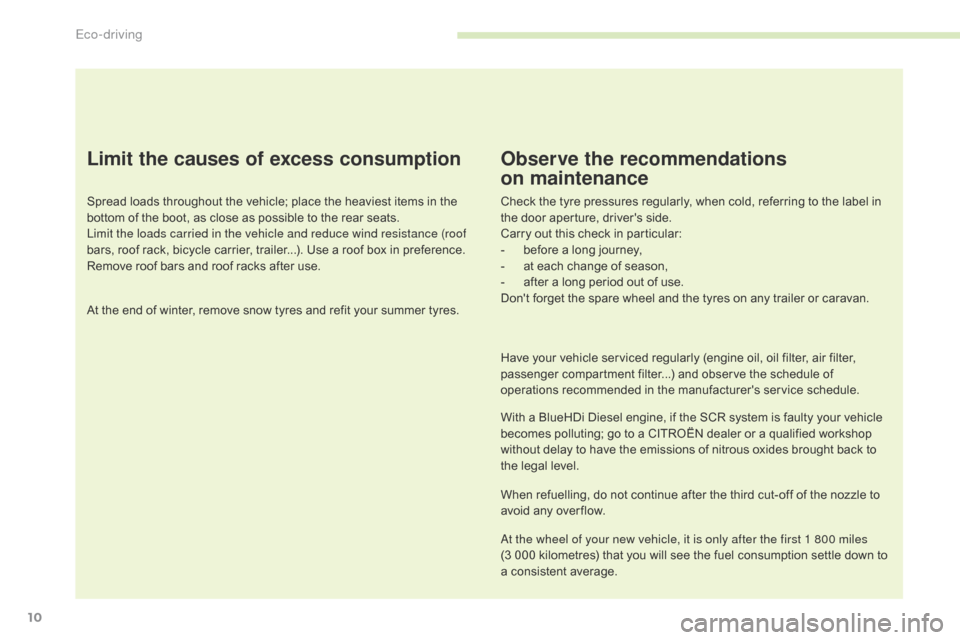
10
C4-Picasso-II_en_Chap00c_eco-conduite_ed01-2016
Limit the causes of excess consumption
Spreadô loadsô throughoutô theô vehicle;ô placeô theô heaviestô itemsô inô theô bottom ô of ô the ô boot, ô as ô close ô as ô possible ô to ô the ô rear ô seats.
Limit the loads carried in the vehicle and reduce wind resistance (roof
bars,
ô roof ô rack, ô bicycle ô carrier, ô trailer...). ô Use ô a ô roof ô box ô in ô preference.
Remove
ô roof ô bars ô and ô roof ô racks ô after ô use.
At
ô the ô end ô of ô winter, ô remove ô snow ô tyres ô and ô refit ô your ô summer ô tyres.
Observe the recommendations
on maintenance
Checkô theô tyreô pressuresô regularly,ô whenô cold,ô referringô toô theô labelô inô the ô door ô aperture, ô driver's ô side.
Carry
ô out ô this ô check ô in ô particular:
-
ô
b
efore ô a ô long ô journey,
-
ô
a
t ô each ô change ô of ô season,
-
ô
a
fter ô a ô long ô period ô out ô of ô use.
Don't
ô forget ô the ô spare ô wheel ô and ô the ô tyres ô on ô any ô trailer ô or ô caravan.
Have
ô your ô vehicle ô serviced ô regularly ô (engine ô oil, ô oil ô filter, ô air ô filter, ô
p
assenger ô compartment ô filter...) ô and ô observe ô the ô schedule ô of ô
o
perations ô recommended ô in ô the ô manufacturer's ô service ô schedule.
With
ô a ô BlueHDi ô Diesel ô engine, ô if ô the ô SCR ô system ô is ô faulty ô your ô vehicle ô
b
ecomes ô polluting; ô go ô to ô a ô CITROûN ô dealer ô or ô a ô qualified ô workshop ô
w
ithout ô delay ô to ô have ô the ô emissions ô of ô nitrous ô oxides ô brought ô back ô to ô
t
he ô legal ô level.
When
ô refuelling, ô do ô not ô continue ô after ô the ô third ô cut-off ô of ô the ô nozzle ô to ô
a
void ô any ô over flow.
At the wheel of your new vehicle, it is only after the first 1 800 miles
(3ô 000
ô kilometres) ô that ô you ô will ô see ô the ô fuel ô consumption ô settle ô down ô to ô
a
ô consistent ô average.
Eco-driving
Page 276 of 527
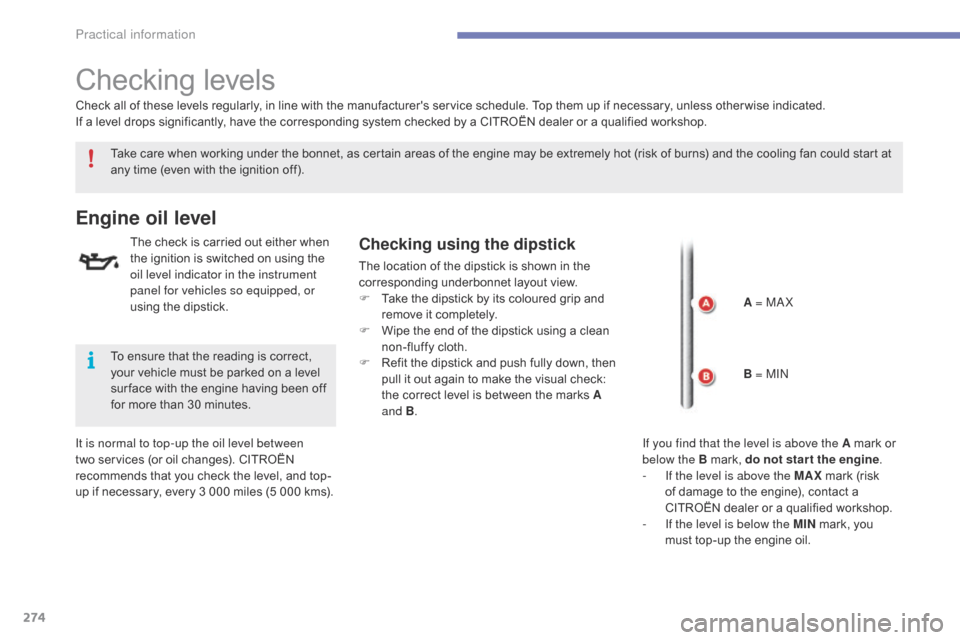
274
C4-Picasso-II_en_Chap07_info-pratiques_ed01-2016
Checkingô levels
Takeô careô whenô workingô underô theô bonnet,ô asô certainô areasô ofô theô engineô mayô beô extremelyô hotô (riskô ofô burns)ô andô theô coolingô fanô couldô startô atô any ô time ô (even ô with ô the ô ignition ô off).
Engine oil level
Theô checkô isô carriedô outô eitherô whenô the ô ignition ô is ô switched ô on ô using ô the ô
o
il level indicator in the instrument
panel for vehicles so equipped, or
using
ô the ô dipstick.Checking using the dipstick
Theô locationô ofô theô dipstickô isô shownô inô theô corresponding ô underbonnet ô layout ô view.
F
ô
T
ake ô the ô dipstick ô by ô its ô coloured ô grip ô and ô
r
emove ô it ô completely.
F
ô
W
ipe ô the ô end ô of ô the ô dipstick ô using ô a ô clean ô
n
on-fluffy ô cloth.
F
ô
R
efit ô the ô dipstick ô and ô push ô fully ô down, ô then ô
p
ull ô it ô out ô again ô to ô make ô the ô visual ô check: ô
t
he ô correct ô level ô is ô between ô the ô marks ô A
and B .
It is normal to top-up the oil level between
two
ô
services
ô
(or
ô
oil
ô
changes).
ô
CITROûN
ô
r
ecommends
ô
that
ô
you
ô
check
ô
the
ô
level,
ô
and
ô
top-
up
ô
if
ô
necessary,
ô
every
ô
3
ô
000
ô
miles
ô
(5
ô
000
ô
kms).
Check
ô
all
ô
of
ô
these
ô
levels
ô
regularly,
ô
in
ô
line
ô
with
ô
the
ô
manufacturer's ô service ô schedule. ô Top ô them ô up ô if ô necessary, ô unless ô other wise ô indicated.
If
ô
a
ô
level
ô
drops
ô
significantly,
ô
have
ô
the
ô
corresponding ô system ô checked ô by ô a ô CITROûN ô dealer ô or ô a ô qualified ô workshop.
To
ô
ensure
ô
that
ô
the
ô
reading
ô
is
ô
correct,
ô
y
our
ô
vehicle
ô
must
ô
be
ô
parked
ô
on
ô
a
ô
level
ô
s
ur face
ô
with
ô
the
ô
engine
ô
having
ô
been
ô
off
ô
f
or
ô
more
ô
than
ô
30
ô
minutes. A = MA X
B = MIN
If you find that the level is above the A
ô mark ô or ô
belo
w the B ô mark, ô do not star t the engine.
-
I
f the level is above the MAX
ô
mark ô (risk ô
o
f ô damage ô to ô the ô engine), ô contact ô a ô
C
ITROûN ô dealer ô or ô a ô qualified ô workshop.
-
I
f the level is below the MIN
ô
mark, ô you ô
m
ust ô top-up ô the ô engine ô oil.
Practical information
Page 277 of 527
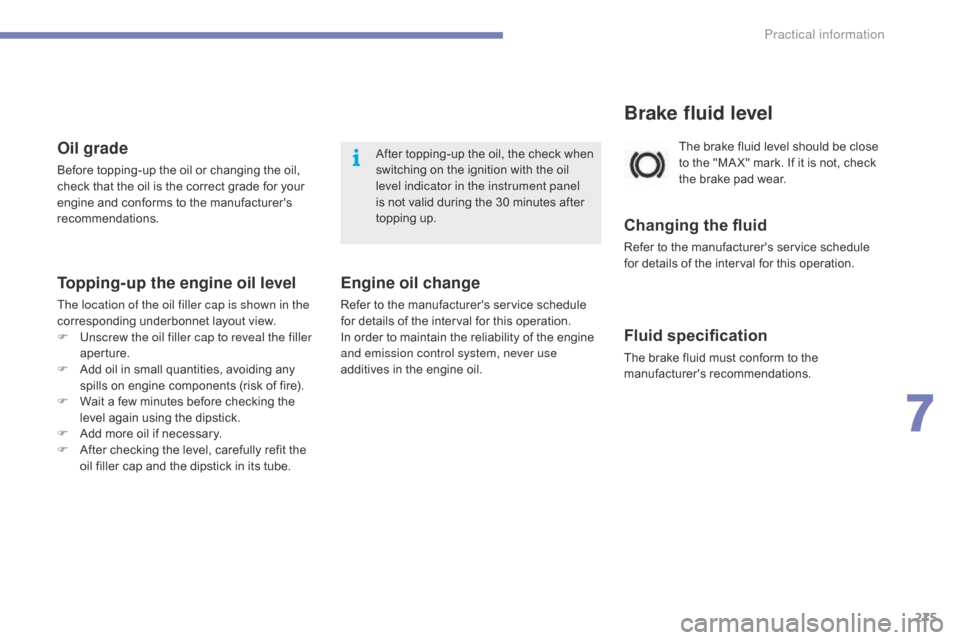
275
C4-Picasso-II_en_Chap07_info-pratiques_ed01-2016
Theô brakeô fluidô levelô shouldô beô closeô to ô the ô "MA X" ô mark. ô If ô it ô is ô not, ô check ô
t
he ô brake ô pad ô wear.
Brake fluid level
Changing the fluid
Referô toô theô manufacturer'sô serviceô scheduleô for ô details ô of ô the ô interval ô for ô this ô operation.
Fluid specification
Theô brakeô fluidô mustô conformô toô theô manufacturer'sô r ecommendations.
Topping-up the engine oil level
The location of the oil filler cap is shown in the
correspondingô underbonnet ô layout ô view.
F
U
nscrew the oil filler cap to reveal the filler
aperture.
F
ô
A
dd ô oil ô in ô small ô quantities, ô avoiding ô any ô
s
pills ô on ô engine ô components ô (risk ô of ô fire).
F
ô
W
ait ô a ô few ô minutes ô before ô checking ô the ô
l
evel ô again ô using ô the ô dipstick.
F
ô
A
dd ô more ô oil ô if ô necessary.
F
ô
A
fter ô checking ô the ô level, ô carefully ô refit ô the ô
o
il ô filler ô cap ô and ô the ô dipstick ô in ô its ô tube.
Engine oil change
Referô toô theô manufacturer'sô serviceô scheduleô for ô details ô of ô the ô interval ô for ô this ô operation.
In
ô order ô to ô maintain ô the ô reliability ô of ô the ô engine ô
a
nd emission control system, never use
additives
ô in ô the ô engine ô oil.
After
ô topping-up ô the ô oil, ô the ô check ô when ô
s
witching ô on ô the ô ignition ô with ô the ô oil ô
l
evel indicator in the instrument panel
is ô not ô valid ô during ô the ô 30 ô minutes ô after ô
t
opping ô up.
Oil grade
Beforeô topping-upô theô oilô orô changingô theô oil,ô c
heck ô that ô the ô oil ô is ô the ô correct ô grade ô for ô your ô
e
ngine ô and ô conforms ô to ô the ô manufacturer's ô
r
ecommendations.
7
Practical information
Page 279 of 527
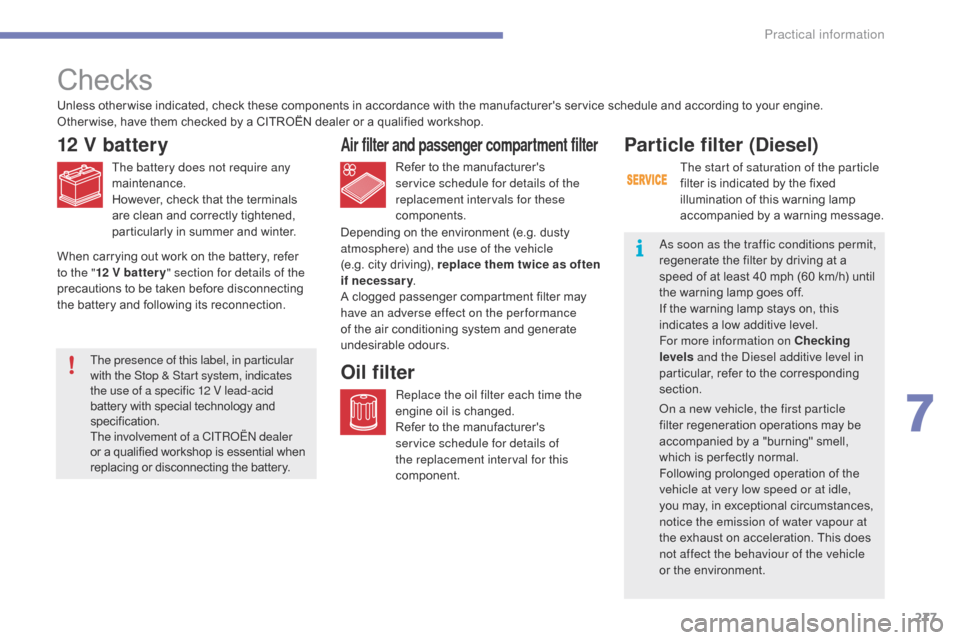
277
C4-Picasso-II_en_Chap07_info-pratiques_ed01-2016
Checks
12 V battery
The battery does not require any
maintenance.
However,ô check ô that ô the ô terminals ô
a
re ô clean ô and ô correctly ô tightened, ô
p
articularly ô in ô summer ô and ô winter.Refer
ô to ô the ô manufacturer's ô s
ervice schedule for details of the
replacement intervals for these
components.
Air filter and passenger compartment filter
Replace the oil filter each time the
engine ô oil ô is ô changed.
Refer
ô to ô the ô manufacturer's ô
s
ervice schedule for details of
the replacement interval for this
component.
Oil filterThe presence of this label, in particular
with the Stop & Start system, indicates
the use of a specific 12 V lead-acid
battery
ô with ô special ô technology ô and
ô s
pecification.
ô T
he involvement of a CITROûN dealer
or
ô a ô qualified ô workshop ô is ô essential ô when
ô r
eplacing ô or ô disconnecting ô the ô battery.
Unless
ô other wise ô indicated, ô check ô these ô components ô in ô accordance ô with ô the ô manufacturer's ô service ô schedule ô and ô according ô to ô your ô engine.
Other wise, ô have ô them ô checked ô by ô a ô CITROûN ô dealer ô or ô a ô qualified ô workshop.
Depending ô on ô the ô environment ô (e.g. ô dusty ô
a
tmosphere) and the use of the vehicle
(e.g.ô city ô driving), ô replace them twice as often
if necessary .
A ô clogged ô passenger ô compartment ô filter ô may ô
h
ave an adverse effect on the per formance
of ô the ô air ô conditioning ô system ô and ô generate ô u
ndesirableô o dours.
Particle filter (Diesel)
The start of saturation of the particle
filter
ô is ô indicated ô by ô the ô fixed ô
i
llumination ô of ô this ô warning ô lamp ô
a
ccompanied ô by ô a ô warning ô message.
As soon as the traffic conditions permit,
regenerate
ô the ô filter ô by ô driving ô at ô a ô
s
peed ô of ô at ô least ô 40 ô mph ô (60 ô km/h) ô until ô
t
he
ô
warning ô lamp ô goes ô off.
If
ô
the ô warning ô lamp ô stays ô on, ô this ô
i
ndicates ô a ô low ô additive ô level.
For more information on Checking
levels and the Diesel additive level in
particular,
ô refer ô to ô the ô corresponding ô
s
ection.
On a new vehicle, the first particle
filter
ô regeneration ô operations ô may ô be ô
a
ccompanied ô by ô a ô "burning" ô smell, ô
w
hich ô is ô per fectly ô normal.
Following
ô prolonged ô operation ô of ô the ô
v
ehicle at very low speed or at idle,
you
ô may, ô in ô exceptional ô circumstances, ô
n
otice the emission of water vapour at
the
ô
exhaust ô on ô acceleration. ô This ô does ô
n
ot affect the behaviour of the vehicle
or
ô
the ô environment.
When
ô
carrying
ô
out
ô
work
ô
on
ô
the
ô
battery,
ô
refer
ô
t
o the " 12 V batter y " section for details of the
precautions
ô
to
ô
be
ô
taken
ô
before
ô
disconnecting
ô
t
he
ô
battery
ô
and
ô
following
ô
its
ô
reconnection.
7
Practical information
Page 280 of 527
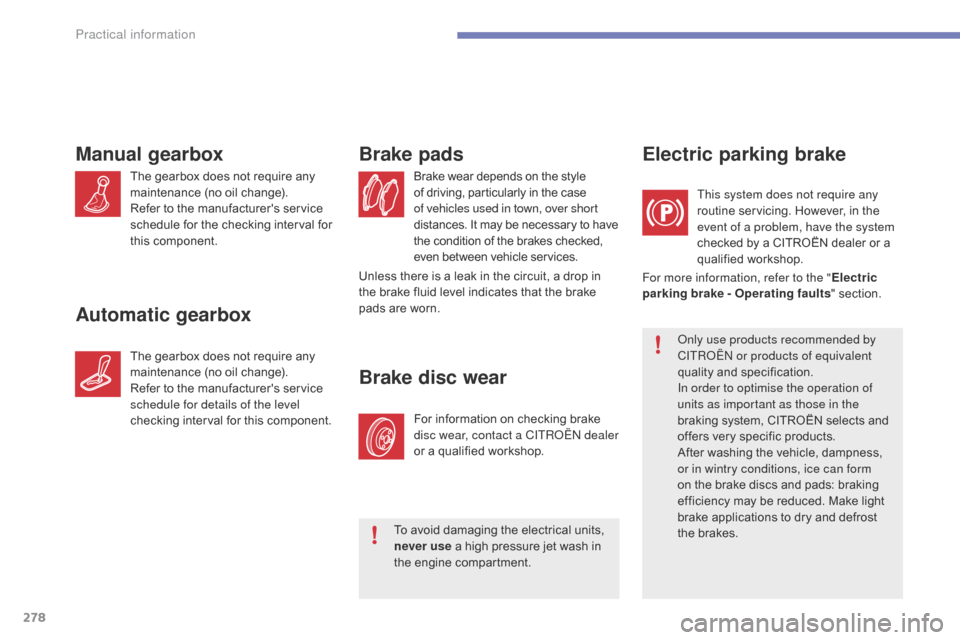
278
C4-Picasso-II_en_Chap07_info-pratiques_ed01-2016
Brakeô wearô dependsô onô theô styleô of ô driving, ô particularly ô in ô the ô caseô o
f vehicles used in town, over short
distances.
ô It ô may ô be ô necessary ô to ô have
ô t
he ô condition ô of ô the ô brakes ô checked,
ô e
ven ô between ô vehicle ô services.
Brake pads
Forô informationô onô checkingô brakeô disc wear, contact a CITROûN dealer
or
ô a ô qualified ô workshop.
Brake disc wear
Only use products recommended by
CITROûN or products of equivalent
quality
ô an
d
ô sp
ecification.
In order to optimise the operation of
units as important as those in the
braking
ô system, ô CITROûN ô selects ô and ô
o
ffers ô very ô specific ô products.
After
ô washing ô the ô vehicle, ô dampness, ô
o
r in wintry conditions, ice can form
on
ô the ô brake ô discs ô and ô pads: ô braking ô
e
fficiency ô may ô be ô reduced. ô Make ô light ô
b
rake ô applications ô to ô dry ô and ô defrost ô
t
he ô brakes.
Electric parking brake
For more information, refer to the " Electric
parking brake - Operating faults "
ô section.
This system does not require any
routine
ô servicing. ô However, ô in ô the ô
e
vent of a problem, have the system
checked ô by ô a ô CITROûN ô dealer ô or ô a ô
q
ualified
ô w
orkshop.
Manual gearbox
Theô gearboxô doesô notô requireô anyô m
aintenance ô (no ô oil ô change).
Refer
ô to ô the ô manufacturer's ô service ô
s
chedule ô for ô the ô checking ô interval ô for ô
t
his
ô c
omponent.
Automatic gearbox
Theô gearboxô doesô notô requireô anyô maintenance ô (no ô oil ô change).
Refer
ô to ô the ô manufacturer's ô service ô
s
chedule for details of the level
checking
ô interval ô for ô this ô component.
To
ô avoid ô damaging ô the ô electrical ô units, ô
n
ever use ô a ô high ô pressure ô jet ô wash ô in ô
t
he ô engine ô compartment.
Unless
ô there ô is ô a ô leak ô in ô the ô circuit, ô a ô drop ô in ô
t
he ô brake ô fluid ô level ô indicates ô that ô the ô brake ô
p
ads ô are ô worn.
Practical information